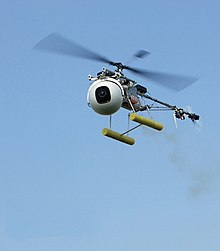
The Helicam is a remote-controlled mini helicopter used to obtain aerial pictures or motion images using video, still or motion film cameras. [1] The remote controlled camera mount system allows pan, tilt and roll movements. A wireless onboard video transmitter downlinks the live signal to the camera operator, images can be recorded on board, on the ground or both. The system is controlled by two operators with independent controls: the helicam pilot and camera operator. [2]
One of the characteristics of the helicam is the flexibility and small size. The system can be flown practically everywhere providing a small spot of about 4 square meters is available to take off and land. Flight endurance ranges from 15 to 30 minutes, refueling can be done in seconds.
Helicams are used in film, [3] sports [4] and a variety of media. [5]